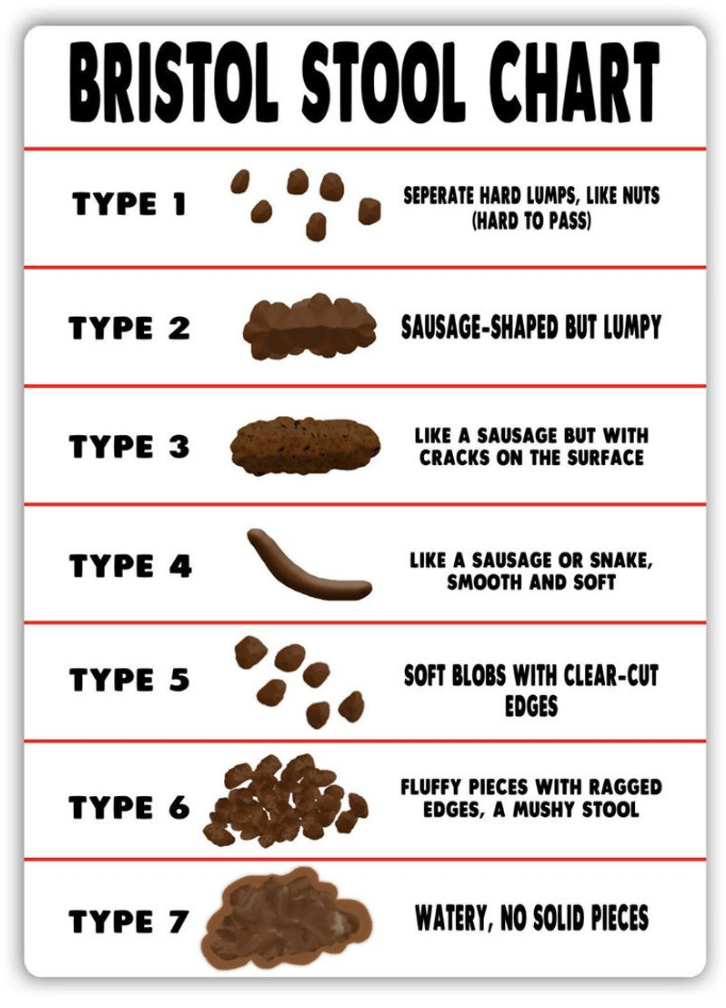Which poo Is Your Child?
When it comes to your child’s bowel movements, it’s not just frequency that matters—it’s also the type. Types 1 and 2 on the Bristol Stool Chart indicate constipation, meaning your child is likely struggling to pass stools. Types 3 and 4 are ideal, as they’re smooth and easy to pass. Type 5 suggests your child is heading towards diarrhea, and Types 6 and 7 mean they already have it.
Why Constipation Matters
Pooping is a major way the body detoxifies. If your child isn’t going regularly, toxins stay trapped in the body, often making skin rashes and itching worse. The connection between constipation and worsening skin symptoms is not a coincidence.
Common Constipation Symptoms in babies and children
Fewer than 1-3 bowel movements a day
Hard, dry, or lumpy stools, or bowel movements that are incomplete
Difficulty or pain while pooping
Bloating, stomach discomfort, or nausea
Large, wide stools
Being fussy and spitting up often
Arching their back
Blood in stools or on toilet paper
Traces of liquid or stool in underwear (possible fecal impaction)
what causes Constipation
Diet: Processed and junk foods, dairy, gluten, low fiber, or high-protein/high-fat diets
Dehydration: Not drinking enough water
Lifestyle: Stress, lack of sleep, physical inactivity, travel, stool holding
Medications: Antacids, acid blockers, anticonvulsants, ADHD medications, antibiotics, antihistamines, iron and calcium supplements, pain medications, antidepressants
Gut Health: Issues with motility, IBS, SIBO, Candida, parasites, digestive problems (low enzymes, stomach acid, or bile), or other imbalances and infections
Steps to Relieve Constipation
Hydration: Aim for 1 glass of water per year of age daily. Under 1 year old and once eating solids, sips of water
Unsweetened fruit juice (grape, pear, apple, cherry, prune, aloe)
Fiber-rich foods: Introduce more fruits, veggies, chia and flaxseed, gluten free steel-cut oats, and whole gluten free grains
Avoid: Dairy, gluten, processed foods, high-sugar snacks, and diets void of or low in fiber
Exercise: Encourage regular physical activity
Castor oil packs: A gentle, natural remedy for relief
Smoothies: Add fiber-rich ingredients like unsweetened prune juice, pears, spinach, blueberries, and chia or flaxseeds to make constipation smoothies
Constipation “nut butter”:
Ingredients
1 cup unsweetened applesauce
1 cup chia or hemp seeds
3/4 cup unsweetened prune juice
Instructions
Mix ingredients together, they will turn into a pasty consistency, like nut butter
Keep refrigerated
Eat one or two tsp each day, and follow it with a glass of water
Maintain, it might take a few days to see results
Supplements: Magnesium citrate, or high dose vitamin C (talk to a practitioner for appropriate dosing)
Lifestyle: Address sleep issues, manage stress, encourage your child to go when they have to, stop toilet training if your child is constipated and start again when it’s resolved
When Diet And Lifestyle Aren’t Enough: Contact your doctor and Get professional support
Why Diarrhea Matters
If your child’s bowel movements are frequent and watery, they may have diarrhea. This can be an indication of gut inflammation, and when chronic, can prevent your child from absorbing nutrients from foods they eat.
Common Diarrhea Symptoms
Stomach cramps
Stomach pain
Bloating
Nausea
Vomiting
Fever
Blood in the stool
Mucus in the stool
Urgent need to go
Steps to relieve diarrhea
Clear liquid diet: Water, herbal teas, apple juice, clear broths, plain gelatin
Diet dos: Small and more frequent meals, applesauce, apples, peaches, oranges, strawberries, bananas, peas, carrots, green beans, yogurt, potatoes and sweet potatoes without the skin, lean beef, pork, turkey, chicken, well-cooked eggs, and tofu
Diet dont’s: Very cold foods, and liquids, and carbonated drinks, fatty, greasy, rich foods, foods that cause gas like chewing gum, dairy products
Lifestyle: Address sleep issues, and manage stress
When Diet And Lifestyle Aren’t Enough: Get professional support
If your child has diarrhea that lasts for more than 24 hours, or if they have pain and cramping, call your doctor.
What your baby’s poo is telling you
As babies grow, their poop changes, reflecting their diet and health.
Texture
Newborn baby poop: Your baby’s poop as a newborn will be thick and tar-like. This should change to a looser and yellow poop within a few days after birth. If it doesn’t, call your pediatrician, it might mean he or she isn’t getting enough milk.
Breastfed baby poop: Breastfed babies have looser stools, this is normal and isn’t necessarily a sign of diarrhea.
Formula-fed baby poop: Babies that are formula fed tend to have poops that are firmer compared to breastfed babies. The color may also be more tan to brown, with some yellow and green.
Introducing solids: When you introduce solids, you can expect your baby’s poop to start looking more like adult poop.
Consistency
Constipation: Hard, dark brown, pebble-like stools that are difficult to pass suggest constipation in your baby
Diarrhea: Infants naturally have looser stools, but frequent, watery stools after each feeding may indicate diarrhea
Mucus or Frothy Poop: This could result from swallowing drool during teething. If not teething, or if the poop is frothy, consult your doctor
Blood: Blood in stool may result from constipation-related straining, a possible infection, or consuming dairy. Contact your doctor
Food Pieces: Undigested food in poop can be normal after starting solids but may also indicate insufficient chewing
Frequency
Newborns: May have infrequent poops initially, which can be normal
Breastfed babies: May poop less often until 3-6 weeks old, while formula-fed babies should poop at least once daily—anything less could signal constipation.
After starting solids: Babies should have daily bowel movements; if not, it may indicate constipation
If your baby’s bowel habits are a concern, contact your Doctor.
Always contact your doctor with concerns about your child’s health. The information provided is not medical advice and it is critical to work with a qualified health professional to safely and effectively address your child’s health issues.
References
doi.org/10.3390/jcm6110099.
doi:10.1038/s41598-017-10835-8.
doi: 10.1038/ajg.2009.655.
doi: 10.3904/kjim.2012.27.3.262.
doi.org/10.1089/act.2018.29190.jcb.
https://medlineplus.gov/ency/article/003125.htm.
https://www.unitypoint.org/blankchildrens/article.aspx?id=40567710-74c7-4ef2-a040-847be9fbd35a.
https://www.healthline.com/health/parenting/baby-poop-color#frequency.


